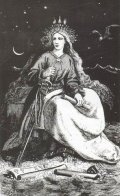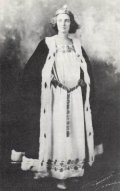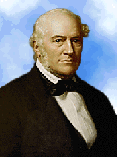It was on June 17,1944, that the modern Icelandic Republic was established, when Iceland broke away from the Danish crown. The country had been independent from Denmark, after centuries of colonial rule, since December 1, 1918. And from that year until 1944, December 1 was celebrated as National Day. By a strange chance, June 17 and December 1, Iceland's two national days, are both dedicated to the Anglo-Saxon St. Botolph. However, this saint is not known to have been invoked in Iceland.
The choice of June 17 for the establishment of the republic was no haphazard chance, but a mark of respect for the memory of the principal hero of Iceland's struggle for independence in the 19th century,
Jón Sigurðsson (1811-1879), whose birthday was June 17. The fact that June could be expected to offer favourable weather for celebrations was an additional bonus.
A vociferous champion of the Icelanders' right to rule themselves, Jón Sigurðsson did not live to see his country gain independence, although an important step forward was taken in 1874, when Iceland was granted a constitution. Jón Sigurðsson, who was president of the Literary Association, is generally referred to by the honorific title of
Jón forseti, "president."
 |
| Sveinn Björnsson |
As early as 1886, when Jón Sigurðsson would have been 75 years old, his birthday was celebrated privately in Reykjavík, and the event was repeated the following year.
In 1907, Jón Sigurðsson's birthday was celebrated by advocates of independence in Reykjavík, Akureyri and Ísafjörður. At this time, opinion was divided in Iceland between those who favoured immediate independence and those who preferred to progress gradually via home rule towards independence. The independence lobby campaigned for Iceland to have its own flag, a white cross on a blue ground, and this flag was raised on many flagpoles around Reykjavík on June 17, 1907, when a crowd of 5,000 people assembled outside Parliament House to hear speeches in favour of independence. At this time the population of Reykjavík was only about 10.000, so attendance at this protest meeting may justly be regarded as remarkable.
For the next few years, June 17 was characterized by disharmony between the different factions, and the Home Rule party (by this time representing moderation) accused their opponents of misusing Jón Sigurðsson's name and reputation to their own ends.
 |
| Ásgeir Ásgeirsson |
By 1911 (the centenary of Jón Sigurðsson's birth), June 17 was celebrated all over the country. June 17, 1911 was the day chosen for the official establishment of the University of Iceland, an institution on which the nation built high hopes for its future.
Later in 1911, a statue of President Jón by Einar Jónsson was erected outside Government House. Twenty years later, the statue was moved to Austurvöllur square opposíte Parliament House, displacing a statue of Icelandic-Danish sculptor Bertel Thorvaldsen.
From 1911 onwards, Jón Sigurðsson's birthday was established as a national festival, when wreaths were often laid at his grave. From 1911 to 1944, the year of independence, sporting events were the order of the day on June 17.
When Iceland became an autonomous nation under the Danish crown in 1918, the Danes and Icelanders agreed that the arrangement would be re-examined after 25 years. But in 1943, when 25 years had passed, World War II was raging. Denmark was occupied by the Germans, and Iceland by the Allies, so it was practically impossible to initiate any kind of negotiations.
 |
| Kristján Eldjárn |
Some Icelanders felt that a decision should be postponed until the war was over, while others felt that a republic could be established unilaterally. The question was put to the people in a plebiscite, in which 97% favoured the immediate declaration of a republic. There was some controversy over the choice of date. December 1, the date of Icelandic independence in 1918, had some advocates, but June 17 had the undoubted advantage of summer weather, in addition to the symbolic link with "President Jón."
The republic was founded at
Þingvellir, the site of the ancient Icelandic parliament, on June 17, 1944, when the first president, Mr.
Sveinn Björnsson, was elected by acclamation. The presidency, a nonpolitical office in Iceland, was held by Sveinn Björnsson until 1952. He was followed by Mr.
Ásgeir Ásgeirsson (1952-68), Mr.
Kristján Eldjárn (1968-80) and Mrs.
Vigdís Finnbogadóttir (1980-1996), the first democratically elected woman head of state in the world.
 |
Vigdís
Finnbogadóttir |
Mrs. Vigdís Finnbogadóttir was followed in 1996 by the present president, Mr.
Ólafur Ragnar Grímsson.
The ceremonies and events of National Day have gradually developed since 1944. Every year since 1945, the president of the republic has laid a wreath at the foot of the statue of Jón Sigurðsson. In 1947, the Reykjavík town council first laid a wreath on Jón Sigurðsson's grave. The prime minister gives an address on National Day; from 1946 to 1966 this addness was delivered from the balcony of Parliament House, but since 1971, the prime minister has made his National Day speech from the square outside.
On National Day, the Icelandic nation is ceremonially represented as Fjallkonan, the Lady of the Mountains, who appears in formal national dress to give a recitation in prose or verse in honour of her country. The personification of Iceland as a woman, somewhat reminiscent of such mythical figures as Germania in Germany, Marianne in France and Britannia in Britain, first occurs in 18th-century poetry. In the 19th century she became familiar as the Lady of the Mountains. It was, however, in emigrant Icelandic communities in the New World, formed by Icelanders who left their homes to seek a better life in the decades after 1875, that women fírst dressed up to play the role of the
 |
Ólafur Ragnar
Grímsson |
symbolic Lady on special occasions. Since 1924, the Icelandic community in Winnipeg, Canada, has included an address by the Lady of the Mountains in the programme of
Íslendingadagurinn, Icelanders' Day, which is celebrated at the beginning of August. In Canada, the Lady of the Mountains, symbol of the old country, is generally represented by a lady of mature years, who has earned respect within the Icelandic-Canadian communíty. This Icelandic-Canadian custom undoubtediy influenced the decision to inciude the Lady of the Mountains in celebrations of National Day back home in Iceland. In the young Icelandic Republic, the Lady of the Mountains has normally been represented by a young actress.
For the first few years after independence, National Day was celebrated with solemnity, and although there was dancing in the streets, drunkenness on National Day was almost unknown. In later decades, however, June 17 developed into an occasion of general merriment. Ceremonial speeches and wreath-laying are confined to the morning, while the afternoon is a raucous occasion, characterized by parades, music, clowns, hot-dog stands, balloons and candy-floss.
 |
The Icelandic flag. |
The day culminates with dancing in the streets in the evening, when many Icelanders find it in keepíng to partake of alcoholic refreshment.
Although June 17 was regarded as National Day from the foundation of the republic in 1944, it was not immediately established as such by law. In 1945, June 17 was declared National Day, superseding December 1, and the government made a recommendation that employers give their staff a holiday on June 17. This was repeated every year until 1969, when June 17 was established as a holiday by most wage agreements. In 1971, National Day was finally established as a national holiday. June 17 is an official flag day.
Ref.: "High Days and Holidays in Iceland" by Dr. Árni Björnsson, published by Mál og menning 1995.










